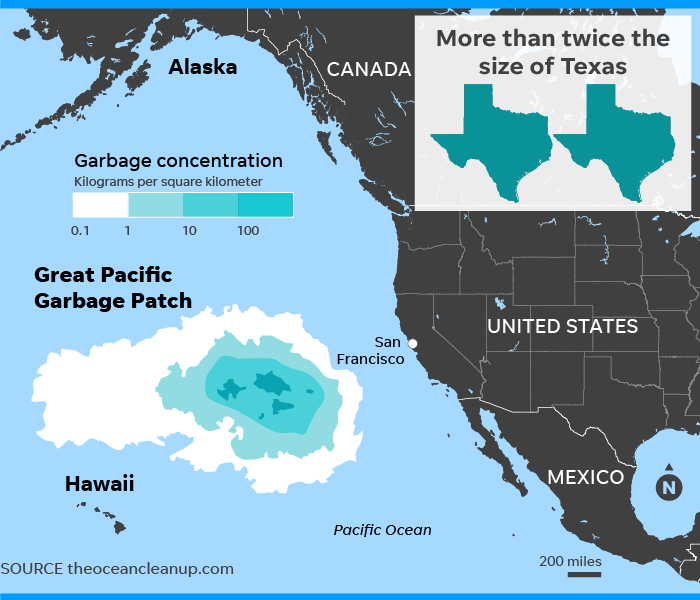World's largest collection of ocean garbage is now twice the size of Texas

he world's largest collection of ocean garbage is growing.
The Great Pacific Garbage Patch, a collection of plastic, floating trash located halfway between Hawaii and California, has grown to more than 600,000 square miles, a study published Thursday finds. That's twice the size of Texas.
Winds and converging ocean currents funnel the garbage into a central location, said study lead author Laurent Lebreton of the Ocean Cleanup Foundation, a non-profit organization that spearheaded the research.
First discovered in the early 1990s, Lebreton said the trash in the patch comes from countries around the Pacific Rim, including nations in Asia as well as North and South America.
The patch is not a solid mass of plastic. It includes some 1.8 trillion pieces of plastic and weighs 88,000 tons — the equivalent of 500 jumbo jets. The new figures are as much as 16 times higher than previous estimates.
The research — the most complete study ever undertaken of the garbage patch — was published Thursday in the peer-reviewed journal Nature Scientific Reports.
Much of the garbage is rather large. "We were surprised by the amount of large plastic objects we encountered,” said Julia Reisser, also of the foundation. “We used to think most of the debris consists of small fragments, but this new analysis shines a new light on the scope of the debris."
The study was based on a three-year mapping effort conducted by an international team of scientists affiliated with the Ocean Cleanup Foundation, six universities and an aerial sensor company.
Sadly, the Pacific patch isn't alone. The Great Pacific Garbage Patch is the largest of five known such trash collections in the ocean, Lebreton said.
Scientists are working with the European Space Agency to take photos of the various garbage patches from space.
With no governments stepping up to clean up the trash in the world's oceans, which are in international waters, it's up to privately funded groups like the Ocean Cleanup Foundation to take the lead on getting rid of the garbage.
And there's a sense of urgency, said Joost Dubois, a spokesman with the foundation. It will be far easier to collect the trash while most of it is rather large before it breaks down into smaller pieces, he said.
"It's a ticking time bomb of larger material," Dubois said. "We've got to get it before it breaks down into a size that's too small to collect and also dangerous for marine life."
Since plastic has only been around since the 1950s, there's no way of knowing exactly how long it will last in the ocean. If left alone, the plastic could remain there for decades, centuries or even longer.
"How long plastic may remain in the ocean is a big unknown, but unless we begin to remove it, some would say it may remain there forever," Lebreton said.
=====================================================================
source:https://www.usatoday.com/story/tech/science/2018/03/22/great-pacific-garbage-patch-grows/446405002/




Post a Comment Blogger Facebook
EmoticonClick to see the code!
To insert emoticon you must added at least one space before the code.